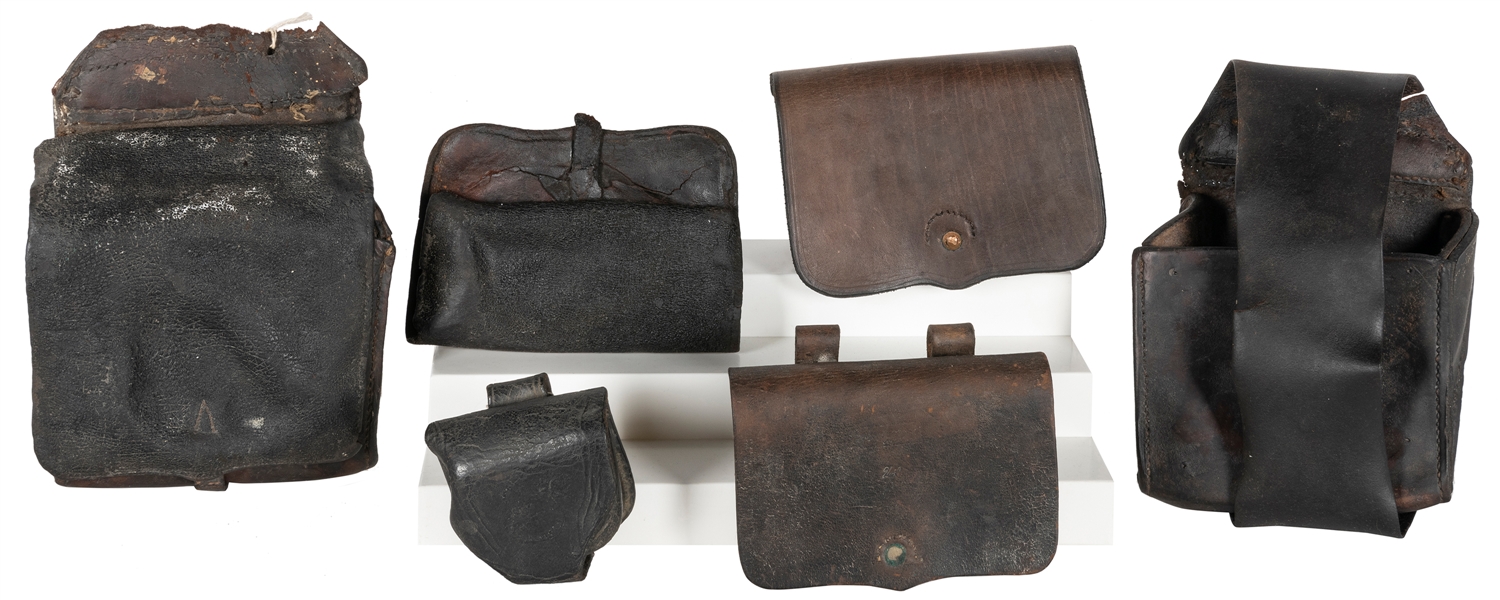CDV, period copy of a Mathew Brady view identified in pencil as "Capt. CRP Rogers" on verso. (Excellent, strong corners.) Factually, this is illustrious 'old navy' officer C.R. Perry Rodgers who entered as Midshipman, 10/5/33; Passed Midshipman,7/8/39; Lieutenant. 9/4/44; Commander, 11/15/61; Captain, 7/25/66; Commodore, 8/28/70; Rear-Admiral, 6/14/74; Retired List, 11/14/81, Died 1/8/92. With the advent of war, Rodgers was serving as Commandant of Midshipmen at the Naval Academy and oversaw its relocation to Newport, RI for the duration. He then took command of the steam frigate Wabash, flagship of the South Atlantic Blockading Squadron, and would distinguish himself at the Battle of Port Royal on November 7, 1861 which was recognized by an immediate promotion to commander. Rodgers saw more action during the capture of Fort Pulaski in April 1862 before assuming command of the recently commissioned broadside ironclad USS New Ironsides at Charleston in 1863. Admiral DuPont noted, "No language could overstate his services to his country and to myself." Arguably, Admiral Rodgers' most significant career achievement occurred while serving as Commandant of the Naval Academy from September 1874 through July 1878. As the navy declined in the post-war years reflecting an institutional retrograde to a benign "sailing ships and smoothbore cannon" mentality, Rodgers revamped and upgraded the Academy's curriculum studied by the future officer corps. The emphasis shifted to upper level engineering and first ever mechanical engineering courses. First and second year classmen were now exposed to advanced mathematics, mechanics, physics, and chemistry subjects rather than strictly rote memorization of navy tradition and dogma. The shift in emphasis would have a profound impact on the future officer corps and "laid the groundwork for an American naval renaissance in the 1880s." [With:] CDV, full standing portrait copy shot identified twice on verso as "Capt. Pennock." New York: Anthony, [1860s]. (Light, albumen separated from the mount nearly 2/3 from the bottom, bottom corners clipped, good.) Alexander Mosley Pennock (1814-1876) was another 'old salt' who joined as Midshipman, 4/1/28; Passed Midshipman, 6/14/34; Lieutenant, 2/25/41; Commander, 12/15/55; Captain, 1/2/63; Commodore, 5/6/68; Rear-Admiral, 7/19/72; Died 9/20/76. In January 1862 Commander Pennock assumed command of the fledgling navy base at Cairo, Illinois and oversaw the construction/conversion of dozens of Brown Water Navy warships while managing both base and fleet logistics. Additionally, in September 1862 he took command of the Upper River Flotilla which patrolled the wide ranges of the Cumberland, Tennessee, and Ohio Rivers for the duration of the war. Captain Pennock's zeal and diligence earned him "a reputation as one of the best wartime executives of the navy." The crowning achievement was promotion to rear-admiral in 1872. [With:] CDV, officer vignette reflecting the rank of master, autographed in heavy ink, "Yours truly / S.W. Mather." 165 Eight Ave.: Young &. Co., [1860s]. (Very good with strong tones, bold signature, minor edge wear along mount.) S.W. Mather became Acting Master 5/17/61 and was Killed in Action 3/22/62 at Mosquito Inlet (Lagoon), Fla. This obscure riverine action was a reconnaissance undertaken by US Gunboats Penguin and Henry Andrews Mather's ship. The Union crews were carried up the St. Johns River in five boats containing 43 men. In the confines of narrow water the caravan was ambushed by local Southern irregulars, the violence resulting in 8 killed including Mather, 8 more wounded, and 3 captured including the African American pilot - name never known - who was later hung by the same group of partisans. A compelling account of the ambush, Mather's instant death, and atrocity committed on the pilot is found in Bluejackets and Contrabands: African Americans and the Union Navy, 2009 (pp.183-185). The Richard B. Cohen Civil War Collection Lots 79-98
CDV, period copy of a Mathew Brady view identified in pencil as "Capt. CRP Rogers" on verso. (Excellent, strong corners.) Factually, this is illustrious 'old navy' officer C.R. Perry Rodgers who entered as Midshipman, 10/5/33; Passed Midshipman,7/8/39; Lieutenant. 9/4/44; Commander, 11/15/61; Captain, 7/25/66; Commodore, 8/28/70; Rear-Admiral, 6/14/74; Retired List, 11/14/81, Died 1/8/92. With the advent of war, Rodgers was serving as Commandant of Midshipmen at the Naval Academy and oversaw its relocation to Newport, RI for the duration. He then took command of the steam frigate Wabash, flagship of the South Atlantic Blockading Squadron, and would distinguish himself at the Battle of Port Royal on November 7, 1861 which was recognized by an immediate promotion to commander. Rodgers saw more action during the capture of Fort Pulaski in April 1862 before assuming command of the recently commissioned broadside ironclad USS New Ironsides at Charleston in 1863. Admiral DuPont noted, "No language could overstate his services to his country and to myself." Arguably, Admiral Rodgers' most significant career achievement occurred while serving as Commandant of the Naval Academy from September 1874 through July 1878. As the navy declined in the post-war years reflecting an institutional retrograde to a benign "sailing ships and smoothbore cannon" mentality, Rodgers revamped and upgraded the Academy's curriculum studied by the future officer corps. The emphasis shifted to upper level engineering and first ever mechanical engineering courses. First and second year classmen were now exposed to advanced mathematics, mechanics, physics, and chemistry subjects rather than strictly rote memorization of navy tradition and dogma. The shift in emphasis would have a profound impact on the future officer corps and "laid the groundwork for an American naval renaissance in the 1880s." [With:] CDV, full standing portrait copy shot identified twice on verso as "Capt. Pennock." New York: Anthony, [1860s]. (Light, albumen separated from the mount nearly 2/3 from the bottom, bottom corners clipped, good.) Alexander Mosley Pennock (1814-1876) was another 'old salt' who joined as Midshipman, 4/1/28; Passed Midshipman, 6/14/34; Lieutenant, 2/25/41; Commander, 12/15/55; Captain, 1/2/63; Commodore, 5/6/68; Rear-Admiral, 7/19/72; Died 9/20/76. In January 1862 Commander Pennock assumed command of the fledgling navy base at Cairo, Illinois and oversaw the construction/conversion of dozens of Brown Water Navy warships while managing both base and fleet logistics. Additionally, in September 1862 he took command of the Upper River Flotilla which patrolled the wide ranges of the Cumberland, Tennessee, and Ohio Rivers for the duration of the war. Captain Pennock's zeal and diligence earned him "a reputation as one of the best wartime executives of the navy." The crowning achievement was promotion to rear-admiral in 1872. [With:] CDV, officer vignette reflecting the rank of master, autographed in heavy ink, "Yours truly / S.W. Mather." 165 Eight Ave.: Young &. Co., [1860s]. (Very good with strong tones, bold signature, minor edge wear along mount.) S.W. Mather became Acting Master 5/17/61 and was Killed in Action 3/22/62 at Mosquito Inlet (Lagoon), Fla. This obscure riverine action was a reconnaissance undertaken by US Gunboats Penguin and Henry Andrews Mather's ship. The Union crews were carried up the St. Johns River in five boats containing 43 men. In the confines of narrow water the caravan was ambushed by local Southern irregulars, the violence resulting in 8 killed including Mather, 8 more wounded, and 3 captured including the African American pilot - name never known - who was later hung by the same group of partisans. A compelling account of the ambush, Mather's instant death, and atrocity committed on the pilot is found in Bluejackets and Contrabands: African Americans and the Union Navy, 2009 (pp.183-185). The Richard B. Cohen Civil War Collection Lots 79-98















Try LotSearch and its premium features for 7 days - without any costs!
Be notified automatically about new items in upcoming auctions.
Create an alert